Critical Analysis of Secondary Data Use in Population Healthcare
VerifiedAdded on 2023/06/18
|39
|15491
|234
Report
AI Summary
This report critically analyses the utilization of secondary health data in influencing healthcare at a population level. It evaluates the importance of secondary data in healthcare, focusing on areas like cost-effectiveness and epidemiological applications. The analysis covers various sources of secondary health data, including consensus data, organizational records, and government information. It discusses the accessibility of data, cost-effectiveness of data extraction, and the quality of data, emphasizing how these factors impact the use of secondary data for improving healthcare services. The report also addresses the challenges in data extraction and the need for better technology integration to enhance the utility of health data in planning and implementing healthcare strategies at a population level, ultimately aiming for better health outcomes and effective resource allocation.
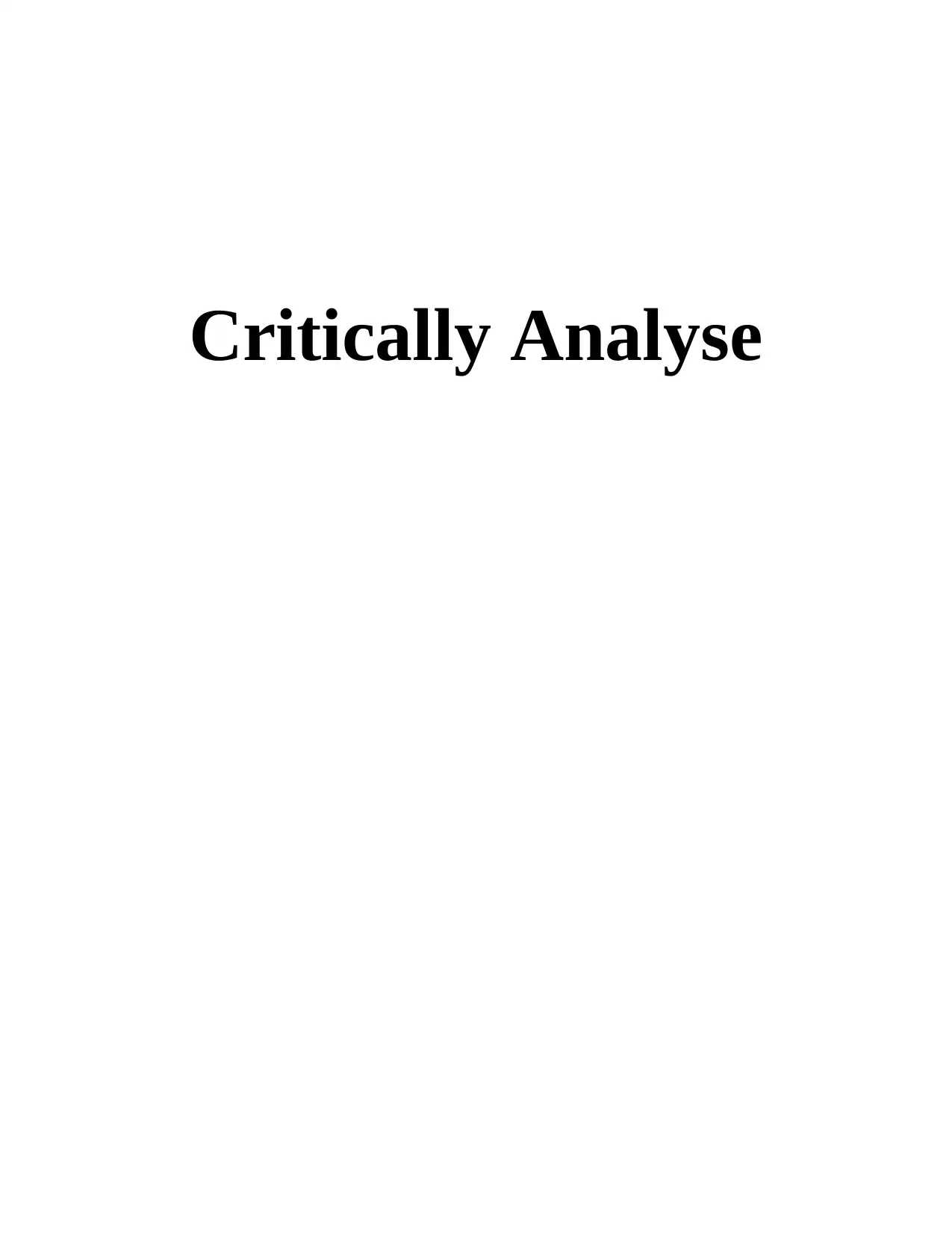
Critically Analyse
Paraphrase This Document
Need a fresh take? Get an instant paraphrase of this document with our AI Paraphraser
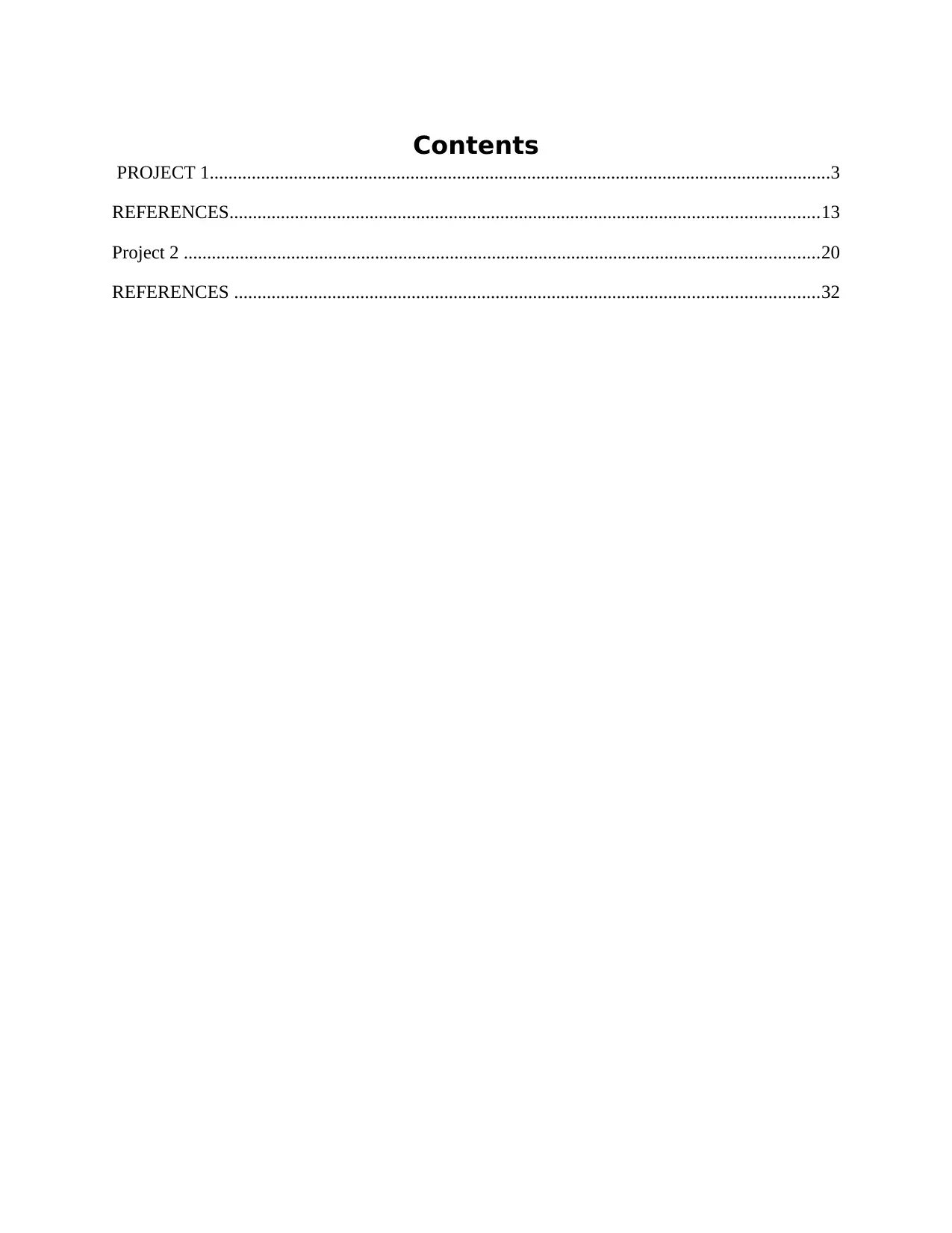
Contents
PROJECT 1.....................................................................................................................................3
REFERENCES..............................................................................................................................13
Project 2 ........................................................................................................................................20
REFERENCES .............................................................................................................................32
PROJECT 1.....................................................................................................................................3
REFERENCES..............................................................................................................................13
Project 2 ........................................................................................................................................20
REFERENCES .............................................................................................................................32
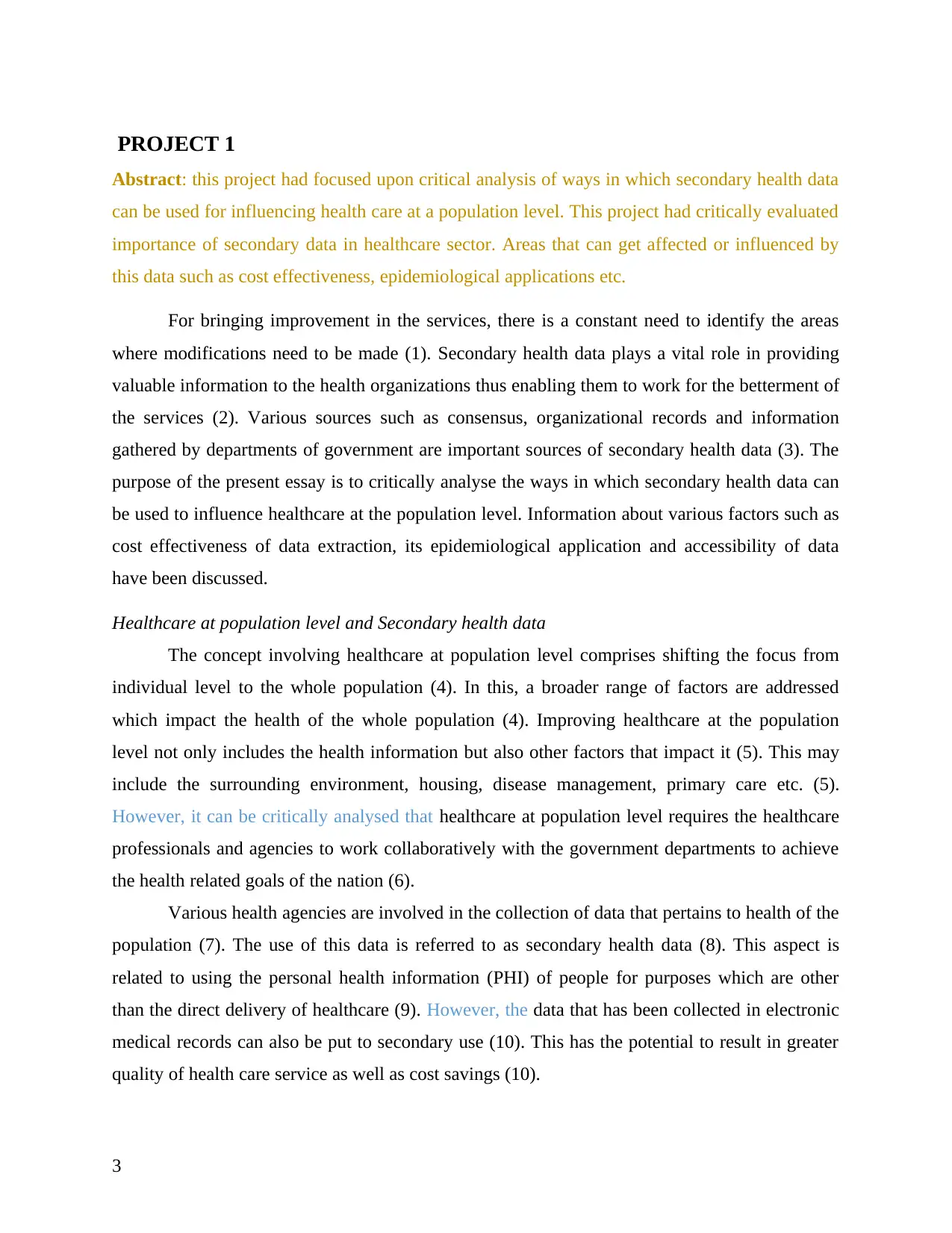
PROJECT 1
Abstract: this project had focused upon critical analysis of ways in which secondary health data
can be used for influencing health care at a population level. This project had critically evaluated
importance of secondary data in healthcare sector. Areas that can get affected or influenced by
this data such as cost effectiveness, epidemiological applications etc.
For bringing improvement in the services, there is a constant need to identify the areas
where modifications need to be made (1). Secondary health data plays a vital role in providing
valuable information to the health organizations thus enabling them to work for the betterment of
the services (2). Various sources such as consensus, organizational records and information
gathered by departments of government are important sources of secondary health data (3). The
purpose of the present essay is to critically analyse the ways in which secondary health data can
be used to influence healthcare at the population level. Information about various factors such as
cost effectiveness of data extraction, its epidemiological application and accessibility of data
have been discussed.
Healthcare at population level and Secondary health data
The concept involving healthcare at population level comprises shifting the focus from
individual level to the whole population (4). In this, a broader range of factors are addressed
which impact the health of the whole population (4). Improving healthcare at the population
level not only includes the health information but also other factors that impact it (5). This may
include the surrounding environment, housing, disease management, primary care etc. (5).
However, it can be critically analysed that healthcare at population level requires the healthcare
professionals and agencies to work collaboratively with the government departments to achieve
the health related goals of the nation (6).
Various health agencies are involved in the collection of data that pertains to health of the
population (7). The use of this data is referred to as secondary health data (8). This aspect is
related to using the personal health information (PHI) of people for purposes which are other
than the direct delivery of healthcare (9). However, the data that has been collected in electronic
medical records can also be put to secondary use (10). This has the potential to result in greater
quality of health care service as well as cost savings (10).
3
Abstract: this project had focused upon critical analysis of ways in which secondary health data
can be used for influencing health care at a population level. This project had critically evaluated
importance of secondary data in healthcare sector. Areas that can get affected or influenced by
this data such as cost effectiveness, epidemiological applications etc.
For bringing improvement in the services, there is a constant need to identify the areas
where modifications need to be made (1). Secondary health data plays a vital role in providing
valuable information to the health organizations thus enabling them to work for the betterment of
the services (2). Various sources such as consensus, organizational records and information
gathered by departments of government are important sources of secondary health data (3). The
purpose of the present essay is to critically analyse the ways in which secondary health data can
be used to influence healthcare at the population level. Information about various factors such as
cost effectiveness of data extraction, its epidemiological application and accessibility of data
have been discussed.
Healthcare at population level and Secondary health data
The concept involving healthcare at population level comprises shifting the focus from
individual level to the whole population (4). In this, a broader range of factors are addressed
which impact the health of the whole population (4). Improving healthcare at the population
level not only includes the health information but also other factors that impact it (5). This may
include the surrounding environment, housing, disease management, primary care etc. (5).
However, it can be critically analysed that healthcare at population level requires the healthcare
professionals and agencies to work collaboratively with the government departments to achieve
the health related goals of the nation (6).
Various health agencies are involved in the collection of data that pertains to health of the
population (7). The use of this data is referred to as secondary health data (8). This aspect is
related to using the personal health information (PHI) of people for purposes which are other
than the direct delivery of healthcare (9). However, the data that has been collected in electronic
medical records can also be put to secondary use (10). This has the potential to result in greater
quality of health care service as well as cost savings (10).
3
⊘ This is a preview!⊘
Do you want full access?
Subscribe today to unlock all pages.

Trusted by 1+ million students worldwide
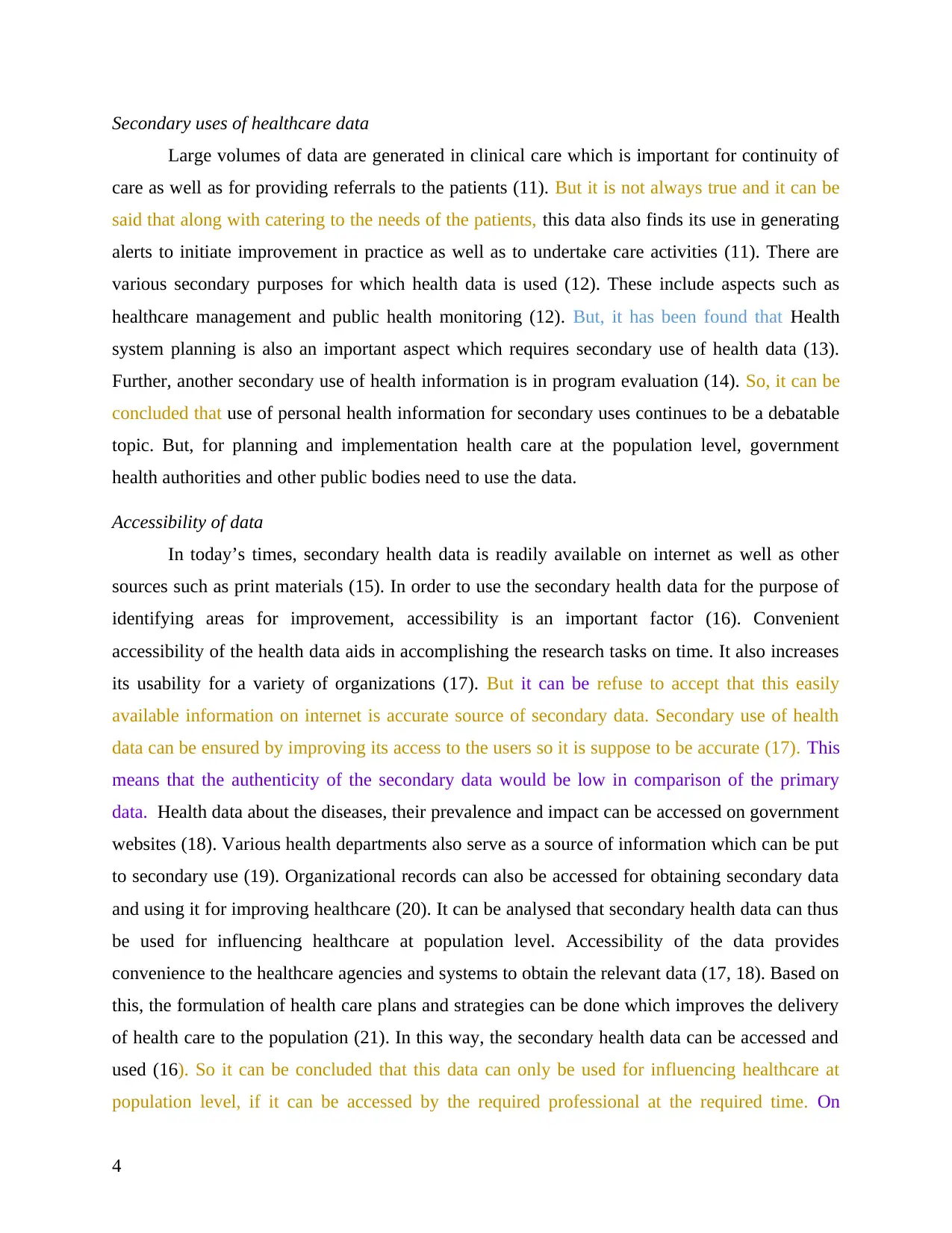
Secondary uses of healthcare data
Large volumes of data are generated in clinical care which is important for continuity of
care as well as for providing referrals to the patients (11). But it is not always true and it can be
said that along with catering to the needs of the patients, this data also finds its use in generating
alerts to initiate improvement in practice as well as to undertake care activities (11). There are
various secondary purposes for which health data is used (12). These include aspects such as
healthcare management and public health monitoring (12). But, it has been found that Health
system planning is also an important aspect which requires secondary use of health data (13).
Further, another secondary use of health information is in program evaluation (14). So, it can be
concluded that use of personal health information for secondary uses continues to be a debatable
topic. But, for planning and implementation health care at the population level, government
health authorities and other public bodies need to use the data.
Accessibility of data
In today’s times, secondary health data is readily available on internet as well as other
sources such as print materials (15). In order to use the secondary health data for the purpose of
identifying areas for improvement, accessibility is an important factor (16). Convenient
accessibility of the health data aids in accomplishing the research tasks on time. It also increases
its usability for a variety of organizations (17). But it can be refuse to accept that this easily
available information on internet is accurate source of secondary data. Secondary use of health
data can be ensured by improving its access to the users so it is suppose to be accurate (17). This
means that the authenticity of the secondary data would be low in comparison of the primary
data. Health data about the diseases, their prevalence and impact can be accessed on government
websites (18). Various health departments also serve as a source of information which can be put
to secondary use (19). Organizational records can also be accessed for obtaining secondary data
and using it for improving healthcare (20). It can be analysed that secondary health data can thus
be used for influencing healthcare at population level. Accessibility of the data provides
convenience to the healthcare agencies and systems to obtain the relevant data (17, 18). Based on
this, the formulation of health care plans and strategies can be done which improves the delivery
of health care to the population (21). In this way, the secondary health data can be accessed and
used (16). So it can be concluded that this data can only be used for influencing healthcare at
population level, if it can be accessed by the required professional at the required time. On
4
Large volumes of data are generated in clinical care which is important for continuity of
care as well as for providing referrals to the patients (11). But it is not always true and it can be
said that along with catering to the needs of the patients, this data also finds its use in generating
alerts to initiate improvement in practice as well as to undertake care activities (11). There are
various secondary purposes for which health data is used (12). These include aspects such as
healthcare management and public health monitoring (12). But, it has been found that Health
system planning is also an important aspect which requires secondary use of health data (13).
Further, another secondary use of health information is in program evaluation (14). So, it can be
concluded that use of personal health information for secondary uses continues to be a debatable
topic. But, for planning and implementation health care at the population level, government
health authorities and other public bodies need to use the data.
Accessibility of data
In today’s times, secondary health data is readily available on internet as well as other
sources such as print materials (15). In order to use the secondary health data for the purpose of
identifying areas for improvement, accessibility is an important factor (16). Convenient
accessibility of the health data aids in accomplishing the research tasks on time. It also increases
its usability for a variety of organizations (17). But it can be refuse to accept that this easily
available information on internet is accurate source of secondary data. Secondary use of health
data can be ensured by improving its access to the users so it is suppose to be accurate (17). This
means that the authenticity of the secondary data would be low in comparison of the primary
data. Health data about the diseases, their prevalence and impact can be accessed on government
websites (18). Various health departments also serve as a source of information which can be put
to secondary use (19). Organizational records can also be accessed for obtaining secondary data
and using it for improving healthcare (20). It can be analysed that secondary health data can thus
be used for influencing healthcare at population level. Accessibility of the data provides
convenience to the healthcare agencies and systems to obtain the relevant data (17, 18). Based on
this, the formulation of health care plans and strategies can be done which improves the delivery
of health care to the population (21). In this way, the secondary health data can be accessed and
used (16). So it can be concluded that this data can only be used for influencing healthcare at
population level, if it can be accessed by the required professional at the required time. On
4
Paraphrase This Document
Need a fresh take? Get an instant paraphrase of this document with our AI Paraphraser
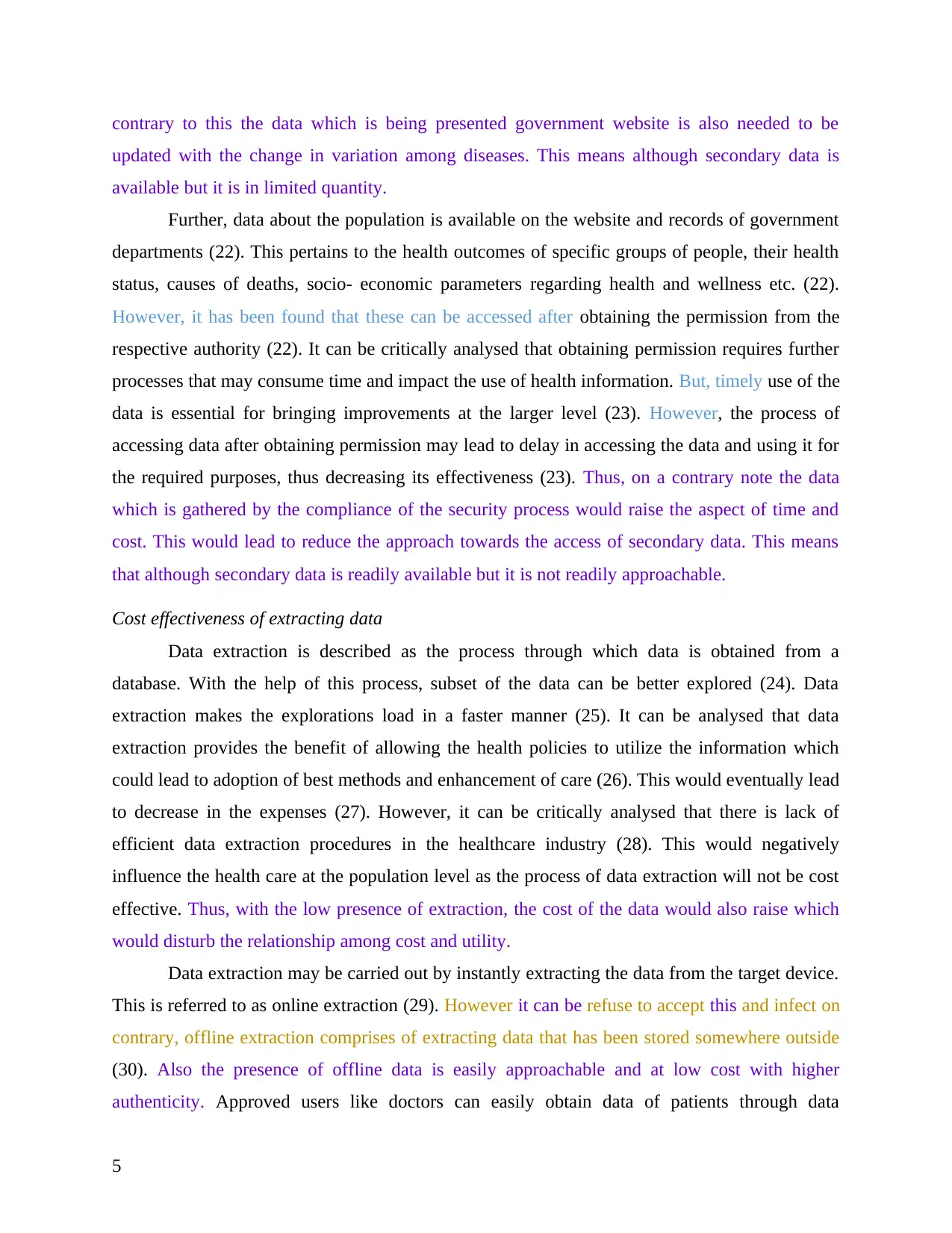
contrary to this the data which is being presented government website is also needed to be
updated with the change in variation among diseases. This means although secondary data is
available but it is in limited quantity.
Further, data about the population is available on the website and records of government
departments (22). This pertains to the health outcomes of specific groups of people, their health
status, causes of deaths, socio- economic parameters regarding health and wellness etc. (22).
However, it has been found that these can be accessed after obtaining the permission from the
respective authority (22). It can be critically analysed that obtaining permission requires further
processes that may consume time and impact the use of health information. But, timely use of the
data is essential for bringing improvements at the larger level (23). However, the process of
accessing data after obtaining permission may lead to delay in accessing the data and using it for
the required purposes, thus decreasing its effectiveness (23). Thus, on a contrary note the data
which is gathered by the compliance of the security process would raise the aspect of time and
cost. This would lead to reduce the approach towards the access of secondary data. This means
that although secondary data is readily available but it is not readily approachable.
Cost effectiveness of extracting data
Data extraction is described as the process through which data is obtained from a
database. With the help of this process, subset of the data can be better explored (24). Data
extraction makes the explorations load in a faster manner (25). It can be analysed that data
extraction provides the benefit of allowing the health policies to utilize the information which
could lead to adoption of best methods and enhancement of care (26). This would eventually lead
to decrease in the expenses (27). However, it can be critically analysed that there is lack of
efficient data extraction procedures in the healthcare industry (28). This would negatively
influence the health care at the population level as the process of data extraction will not be cost
effective. Thus, with the low presence of extraction, the cost of the data would also raise which
would disturb the relationship among cost and utility.
Data extraction may be carried out by instantly extracting the data from the target device.
This is referred to as online extraction (29). However it can be refuse to accept this and infect on
contrary, offline extraction comprises of extracting data that has been stored somewhere outside
(30). Also the presence of offline data is easily approachable and at low cost with higher
authenticity. Approved users like doctors can easily obtain data of patients through data
5
updated with the change in variation among diseases. This means although secondary data is
available but it is in limited quantity.
Further, data about the population is available on the website and records of government
departments (22). This pertains to the health outcomes of specific groups of people, their health
status, causes of deaths, socio- economic parameters regarding health and wellness etc. (22).
However, it has been found that these can be accessed after obtaining the permission from the
respective authority (22). It can be critically analysed that obtaining permission requires further
processes that may consume time and impact the use of health information. But, timely use of the
data is essential for bringing improvements at the larger level (23). However, the process of
accessing data after obtaining permission may lead to delay in accessing the data and using it for
the required purposes, thus decreasing its effectiveness (23). Thus, on a contrary note the data
which is gathered by the compliance of the security process would raise the aspect of time and
cost. This would lead to reduce the approach towards the access of secondary data. This means
that although secondary data is readily available but it is not readily approachable.
Cost effectiveness of extracting data
Data extraction is described as the process through which data is obtained from a
database. With the help of this process, subset of the data can be better explored (24). Data
extraction makes the explorations load in a faster manner (25). It can be analysed that data
extraction provides the benefit of allowing the health policies to utilize the information which
could lead to adoption of best methods and enhancement of care (26). This would eventually lead
to decrease in the expenses (27). However, it can be critically analysed that there is lack of
efficient data extraction procedures in the healthcare industry (28). This would negatively
influence the health care at the population level as the process of data extraction will not be cost
effective. Thus, with the low presence of extraction, the cost of the data would also raise which
would disturb the relationship among cost and utility.
Data extraction may be carried out by instantly extracting the data from the target device.
This is referred to as online extraction (29). However it can be refuse to accept this and infect on
contrary, offline extraction comprises of extracting data that has been stored somewhere outside
(30). Also the presence of offline data is easily approachable and at low cost with higher
authenticity. Approved users like doctors can easily obtain data of patients through data
5
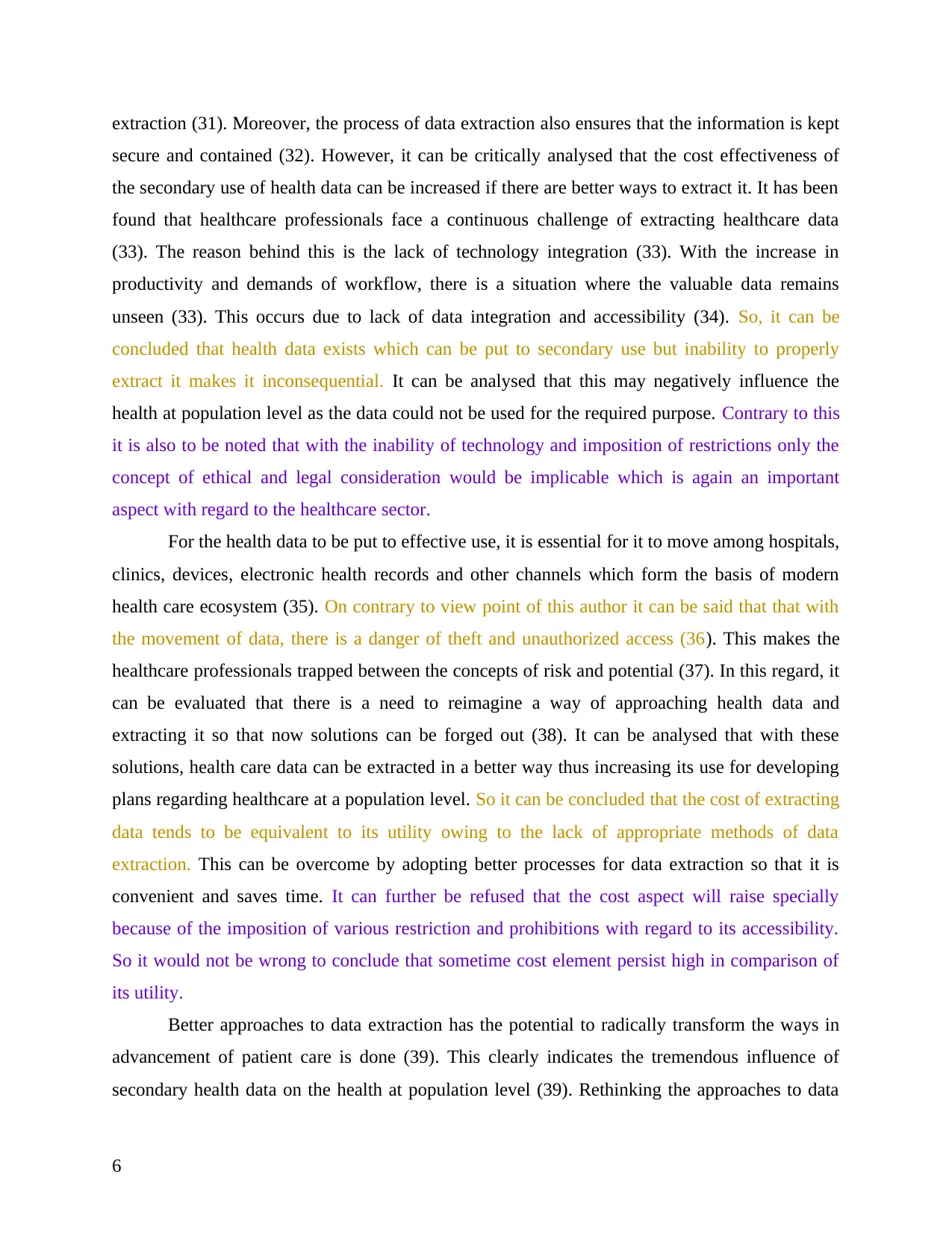
extraction (31). Moreover, the process of data extraction also ensures that the information is kept
secure and contained (32). However, it can be critically analysed that the cost effectiveness of
the secondary use of health data can be increased if there are better ways to extract it. It has been
found that healthcare professionals face a continuous challenge of extracting healthcare data
(33). The reason behind this is the lack of technology integration (33). With the increase in
productivity and demands of workflow, there is a situation where the valuable data remains
unseen (33). This occurs due to lack of data integration and accessibility (34). So, it can be
concluded that health data exists which can be put to secondary use but inability to properly
extract it makes it inconsequential. It can be analysed that this may negatively influence the
health at population level as the data could not be used for the required purpose. Contrary to this
it is also to be noted that with the inability of technology and imposition of restrictions only the
concept of ethical and legal consideration would be implicable which is again an important
aspect with regard to the healthcare sector.
For the health data to be put to effective use, it is essential for it to move among hospitals,
clinics, devices, electronic health records and other channels which form the basis of modern
health care ecosystem (35). On contrary to view point of this author it can be said that that with
the movement of data, there is a danger of theft and unauthorized access (36). This makes the
healthcare professionals trapped between the concepts of risk and potential (37). In this regard, it
can be evaluated that there is a need to reimagine a way of approaching health data and
extracting it so that now solutions can be forged out (38). It can be analysed that with these
solutions, health care data can be extracted in a better way thus increasing its use for developing
plans regarding healthcare at a population level. So it can be concluded that the cost of extracting
data tends to be equivalent to its utility owing to the lack of appropriate methods of data
extraction. This can be overcome by adopting better processes for data extraction so that it is
convenient and saves time. It can further be refused that the cost aspect will raise specially
because of the imposition of various restriction and prohibitions with regard to its accessibility.
So it would not be wrong to conclude that sometime cost element persist high in comparison of
its utility.
Better approaches to data extraction has the potential to radically transform the ways in
advancement of patient care is done (39). This clearly indicates the tremendous influence of
secondary health data on the health at population level (39). Rethinking the approaches to data
6
secure and contained (32). However, it can be critically analysed that the cost effectiveness of
the secondary use of health data can be increased if there are better ways to extract it. It has been
found that healthcare professionals face a continuous challenge of extracting healthcare data
(33). The reason behind this is the lack of technology integration (33). With the increase in
productivity and demands of workflow, there is a situation where the valuable data remains
unseen (33). This occurs due to lack of data integration and accessibility (34). So, it can be
concluded that health data exists which can be put to secondary use but inability to properly
extract it makes it inconsequential. It can be analysed that this may negatively influence the
health at population level as the data could not be used for the required purpose. Contrary to this
it is also to be noted that with the inability of technology and imposition of restrictions only the
concept of ethical and legal consideration would be implicable which is again an important
aspect with regard to the healthcare sector.
For the health data to be put to effective use, it is essential for it to move among hospitals,
clinics, devices, electronic health records and other channels which form the basis of modern
health care ecosystem (35). On contrary to view point of this author it can be said that that with
the movement of data, there is a danger of theft and unauthorized access (36). This makes the
healthcare professionals trapped between the concepts of risk and potential (37). In this regard, it
can be evaluated that there is a need to reimagine a way of approaching health data and
extracting it so that now solutions can be forged out (38). It can be analysed that with these
solutions, health care data can be extracted in a better way thus increasing its use for developing
plans regarding healthcare at a population level. So it can be concluded that the cost of extracting
data tends to be equivalent to its utility owing to the lack of appropriate methods of data
extraction. This can be overcome by adopting better processes for data extraction so that it is
convenient and saves time. It can further be refused that the cost aspect will raise specially
because of the imposition of various restriction and prohibitions with regard to its accessibility.
So it would not be wrong to conclude that sometime cost element persist high in comparison of
its utility.
Better approaches to data extraction has the potential to radically transform the ways in
advancement of patient care is done (39). This clearly indicates the tremendous influence of
secondary health data on the health at population level (39). Rethinking the approaches to data
6
⊘ This is a preview!⊘
Do you want full access?
Subscribe today to unlock all pages.

Trusted by 1+ million students worldwide
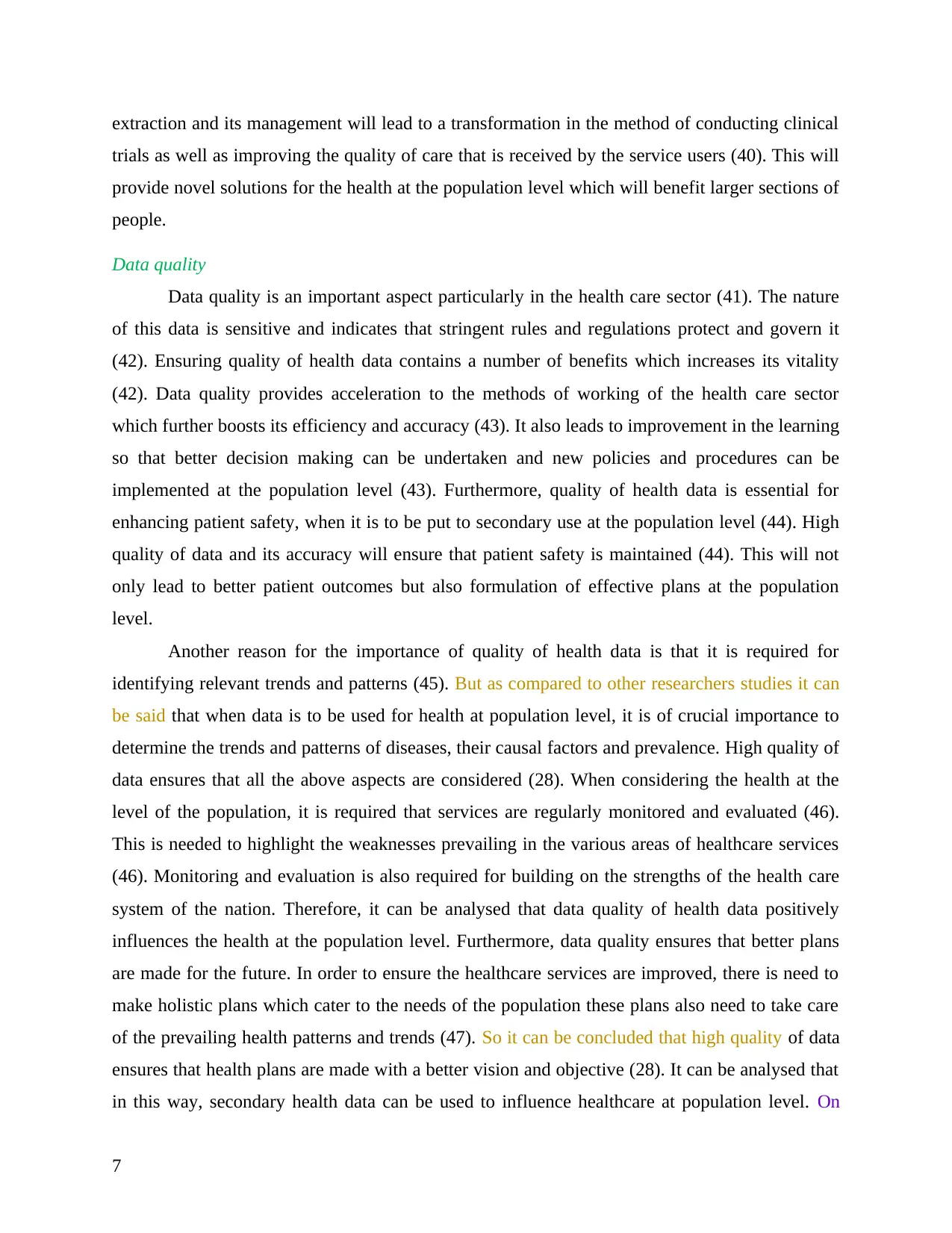
extraction and its management will lead to a transformation in the method of conducting clinical
trials as well as improving the quality of care that is received by the service users (40). This will
provide novel solutions for the health at the population level which will benefit larger sections of
people.
Data quality
Data quality is an important aspect particularly in the health care sector (41). The nature
of this data is sensitive and indicates that stringent rules and regulations protect and govern it
(42). Ensuring quality of health data contains a number of benefits which increases its vitality
(42). Data quality provides acceleration to the methods of working of the health care sector
which further boosts its efficiency and accuracy (43). It also leads to improvement in the learning
so that better decision making can be undertaken and new policies and procedures can be
implemented at the population level (43). Furthermore, quality of health data is essential for
enhancing patient safety, when it is to be put to secondary use at the population level (44). High
quality of data and its accuracy will ensure that patient safety is maintained (44). This will not
only lead to better patient outcomes but also formulation of effective plans at the population
level.
Another reason for the importance of quality of health data is that it is required for
identifying relevant trends and patterns (45). But as compared to other researchers studies it can
be said that when data is to be used for health at population level, it is of crucial importance to
determine the trends and patterns of diseases, their causal factors and prevalence. High quality of
data ensures that all the above aspects are considered (28). When considering the health at the
level of the population, it is required that services are regularly monitored and evaluated (46).
This is needed to highlight the weaknesses prevailing in the various areas of healthcare services
(46). Monitoring and evaluation is also required for building on the strengths of the health care
system of the nation. Therefore, it can be analysed that data quality of health data positively
influences the health at the population level. Furthermore, data quality ensures that better plans
are made for the future. In order to ensure the healthcare services are improved, there is need to
make holistic plans which cater to the needs of the population these plans also need to take care
of the prevailing health patterns and trends (47). So it can be concluded that high quality of data
ensures that health plans are made with a better vision and objective (28). It can be analysed that
in this way, secondary health data can be used to influence healthcare at population level. On
7
trials as well as improving the quality of care that is received by the service users (40). This will
provide novel solutions for the health at the population level which will benefit larger sections of
people.
Data quality
Data quality is an important aspect particularly in the health care sector (41). The nature
of this data is sensitive and indicates that stringent rules and regulations protect and govern it
(42). Ensuring quality of health data contains a number of benefits which increases its vitality
(42). Data quality provides acceleration to the methods of working of the health care sector
which further boosts its efficiency and accuracy (43). It also leads to improvement in the learning
so that better decision making can be undertaken and new policies and procedures can be
implemented at the population level (43). Furthermore, quality of health data is essential for
enhancing patient safety, when it is to be put to secondary use at the population level (44). High
quality of data and its accuracy will ensure that patient safety is maintained (44). This will not
only lead to better patient outcomes but also formulation of effective plans at the population
level.
Another reason for the importance of quality of health data is that it is required for
identifying relevant trends and patterns (45). But as compared to other researchers studies it can
be said that when data is to be used for health at population level, it is of crucial importance to
determine the trends and patterns of diseases, their causal factors and prevalence. High quality of
data ensures that all the above aspects are considered (28). When considering the health at the
level of the population, it is required that services are regularly monitored and evaluated (46).
This is needed to highlight the weaknesses prevailing in the various areas of healthcare services
(46). Monitoring and evaluation is also required for building on the strengths of the health care
system of the nation. Therefore, it can be analysed that data quality of health data positively
influences the health at the population level. Furthermore, data quality ensures that better plans
are made for the future. In order to ensure the healthcare services are improved, there is need to
make holistic plans which cater to the needs of the population these plans also need to take care
of the prevailing health patterns and trends (47). So it can be concluded that high quality of data
ensures that health plans are made with a better vision and objective (28). It can be analysed that
in this way, secondary health data can be used to influence healthcare at population level. On
7
Paraphrase This Document
Need a fresh take? Get an instant paraphrase of this document with our AI Paraphraser
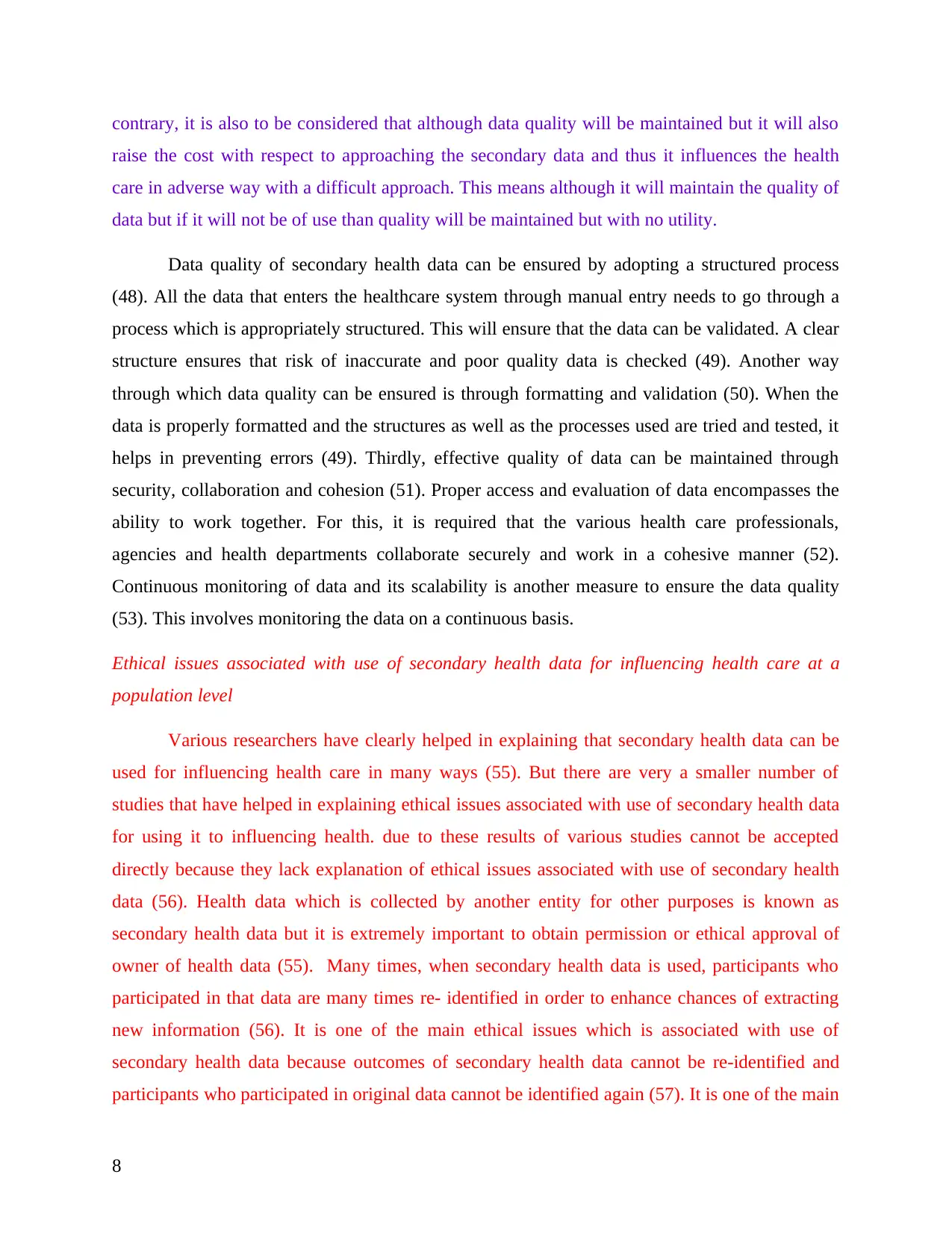
contrary, it is also to be considered that although data quality will be maintained but it will also
raise the cost with respect to approaching the secondary data and thus it influences the health
care in adverse way with a difficult approach. This means although it will maintain the quality of
data but if it will not be of use than quality will be maintained but with no utility.
Data quality of secondary health data can be ensured by adopting a structured process
(48). All the data that enters the healthcare system through manual entry needs to go through a
process which is appropriately structured. This will ensure that the data can be validated. A clear
structure ensures that risk of inaccurate and poor quality data is checked (49). Another way
through which data quality can be ensured is through formatting and validation (50). When the
data is properly formatted and the structures as well as the processes used are tried and tested, it
helps in preventing errors (49). Thirdly, effective quality of data can be maintained through
security, collaboration and cohesion (51). Proper access and evaluation of data encompasses the
ability to work together. For this, it is required that the various health care professionals,
agencies and health departments collaborate securely and work in a cohesive manner (52).
Continuous monitoring of data and its scalability is another measure to ensure the data quality
(53). This involves monitoring the data on a continuous basis.
Ethical issues associated with use of secondary health data for influencing health care at a
population level
Various researchers have clearly helped in explaining that secondary health data can be
used for influencing health care in many ways (55). But there are very a smaller number of
studies that have helped in explaining ethical issues associated with use of secondary health data
for using it to influencing health. due to these results of various studies cannot be accepted
directly because they lack explanation of ethical issues associated with use of secondary health
data (56). Health data which is collected by another entity for other purposes is known as
secondary health data but it is extremely important to obtain permission or ethical approval of
owner of health data (55). Many times, when secondary health data is used, participants who
participated in that data are many times re- identified in order to enhance chances of extracting
new information (56). It is one of the main ethical issues which is associated with use of
secondary health data because outcomes of secondary health data cannot be re-identified and
participants who participated in original data cannot be identified again (57). It is one of the main
8
raise the cost with respect to approaching the secondary data and thus it influences the health
care in adverse way with a difficult approach. This means although it will maintain the quality of
data but if it will not be of use than quality will be maintained but with no utility.
Data quality of secondary health data can be ensured by adopting a structured process
(48). All the data that enters the healthcare system through manual entry needs to go through a
process which is appropriately structured. This will ensure that the data can be validated. A clear
structure ensures that risk of inaccurate and poor quality data is checked (49). Another way
through which data quality can be ensured is through formatting and validation (50). When the
data is properly formatted and the structures as well as the processes used are tried and tested, it
helps in preventing errors (49). Thirdly, effective quality of data can be maintained through
security, collaboration and cohesion (51). Proper access and evaluation of data encompasses the
ability to work together. For this, it is required that the various health care professionals,
agencies and health departments collaborate securely and work in a cohesive manner (52).
Continuous monitoring of data and its scalability is another measure to ensure the data quality
(53). This involves monitoring the data on a continuous basis.
Ethical issues associated with use of secondary health data for influencing health care at a
population level
Various researchers have clearly helped in explaining that secondary health data can be
used for influencing health care in many ways (55). But there are very a smaller number of
studies that have helped in explaining ethical issues associated with use of secondary health data
for using it to influencing health. due to these results of various studies cannot be accepted
directly because they lack explanation of ethical issues associated with use of secondary health
data (56). Health data which is collected by another entity for other purposes is known as
secondary health data but it is extremely important to obtain permission or ethical approval of
owner of health data (55). Many times, when secondary health data is used, participants who
participated in that data are many times re- identified in order to enhance chances of extracting
new information (56). It is one of the main ethical issues which is associated with use of
secondary health data because outcomes of secondary health data cannot be re-identified and
participants who participated in original data cannot be identified again (57). It is one of the main
8
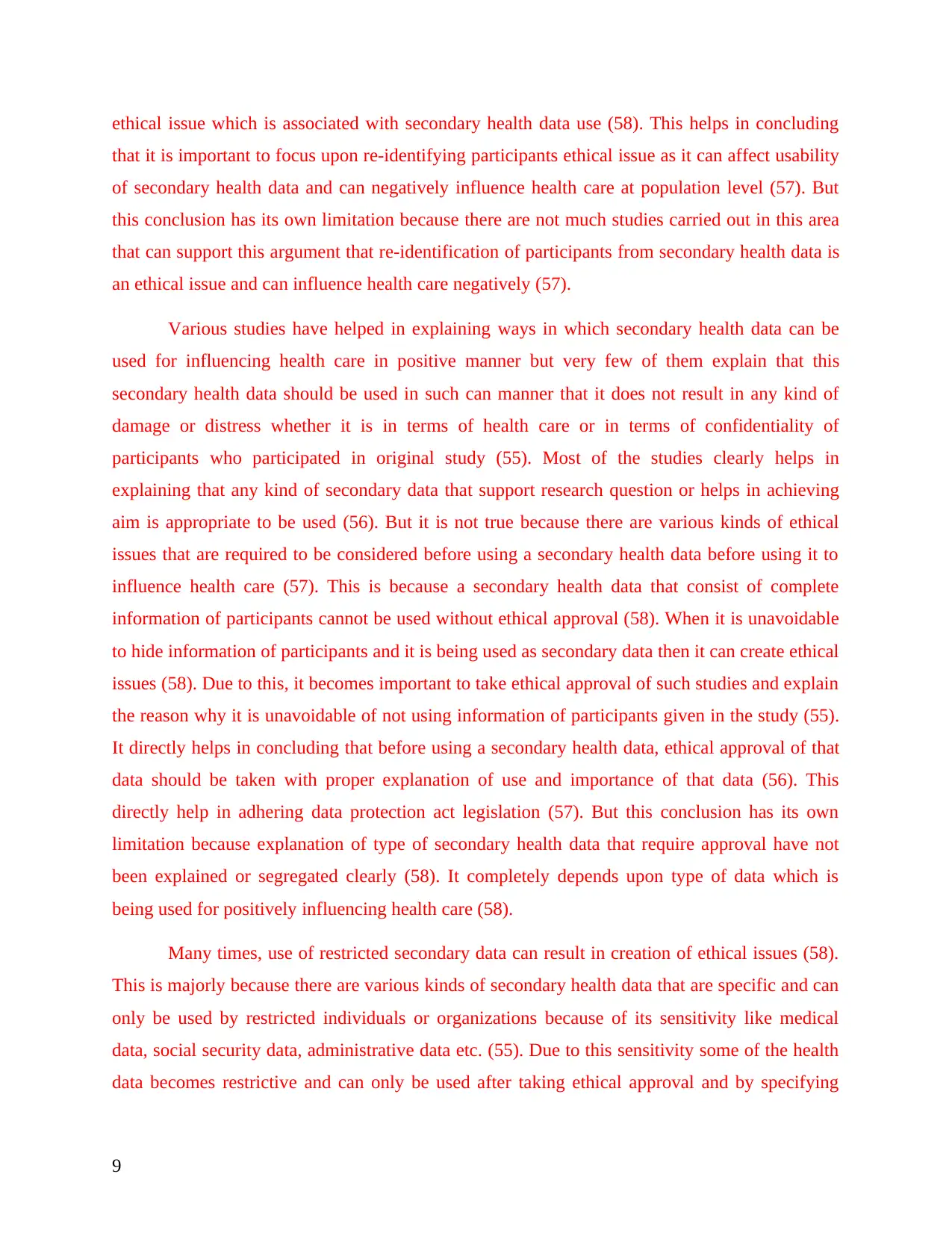
ethical issue which is associated with secondary health data use (58). This helps in concluding
that it is important to focus upon re-identifying participants ethical issue as it can affect usability
of secondary health data and can negatively influence health care at population level (57). But
this conclusion has its own limitation because there are not much studies carried out in this area
that can support this argument that re-identification of participants from secondary health data is
an ethical issue and can influence health care negatively (57).
Various studies have helped in explaining ways in which secondary health data can be
used for influencing health care in positive manner but very few of them explain that this
secondary health data should be used in such can manner that it does not result in any kind of
damage or distress whether it is in terms of health care or in terms of confidentiality of
participants who participated in original study (55). Most of the studies clearly helps in
explaining that any kind of secondary data that support research question or helps in achieving
aim is appropriate to be used (56). But it is not true because there are various kinds of ethical
issues that are required to be considered before using a secondary health data before using it to
influence health care (57). This is because a secondary health data that consist of complete
information of participants cannot be used without ethical approval (58). When it is unavoidable
to hide information of participants and it is being used as secondary data then it can create ethical
issues (58). Due to this, it becomes important to take ethical approval of such studies and explain
the reason why it is unavoidable of not using information of participants given in the study (55).
It directly helps in concluding that before using a secondary health data, ethical approval of that
data should be taken with proper explanation of use and importance of that data (56). This
directly help in adhering data protection act legislation (57). But this conclusion has its own
limitation because explanation of type of secondary health data that require approval have not
been explained or segregated clearly (58). It completely depends upon type of data which is
being used for positively influencing health care (58).
Many times, use of restricted secondary data can result in creation of ethical issues (58).
This is majorly because there are various kinds of secondary health data that are specific and can
only be used by restricted individuals or organizations because of its sensitivity like medical
data, social security data, administrative data etc. (55). Due to this sensitivity some of the health
data becomes restrictive and can only be used after taking ethical approval and by specifying
9
that it is important to focus upon re-identifying participants ethical issue as it can affect usability
of secondary health data and can negatively influence health care at population level (57). But
this conclusion has its own limitation because there are not much studies carried out in this area
that can support this argument that re-identification of participants from secondary health data is
an ethical issue and can influence health care negatively (57).
Various studies have helped in explaining ways in which secondary health data can be
used for influencing health care in positive manner but very few of them explain that this
secondary health data should be used in such can manner that it does not result in any kind of
damage or distress whether it is in terms of health care or in terms of confidentiality of
participants who participated in original study (55). Most of the studies clearly helps in
explaining that any kind of secondary data that support research question or helps in achieving
aim is appropriate to be used (56). But it is not true because there are various kinds of ethical
issues that are required to be considered before using a secondary health data before using it to
influence health care (57). This is because a secondary health data that consist of complete
information of participants cannot be used without ethical approval (58). When it is unavoidable
to hide information of participants and it is being used as secondary data then it can create ethical
issues (58). Due to this, it becomes important to take ethical approval of such studies and explain
the reason why it is unavoidable of not using information of participants given in the study (55).
It directly helps in concluding that before using a secondary health data, ethical approval of that
data should be taken with proper explanation of use and importance of that data (56). This
directly help in adhering data protection act legislation (57). But this conclusion has its own
limitation because explanation of type of secondary health data that require approval have not
been explained or segregated clearly (58). It completely depends upon type of data which is
being used for positively influencing health care (58).
Many times, use of restricted secondary data can result in creation of ethical issues (58).
This is majorly because there are various kinds of secondary health data that are specific and can
only be used by restricted individuals or organizations because of its sensitivity like medical
data, social security data, administrative data etc. (55). Due to this sensitivity some of the health
data becomes restrictive and can only be used after taking ethical approval and by specifying
9
⊘ This is a preview!⊘
Do you want full access?
Subscribe today to unlock all pages.

Trusted by 1+ million students worldwide
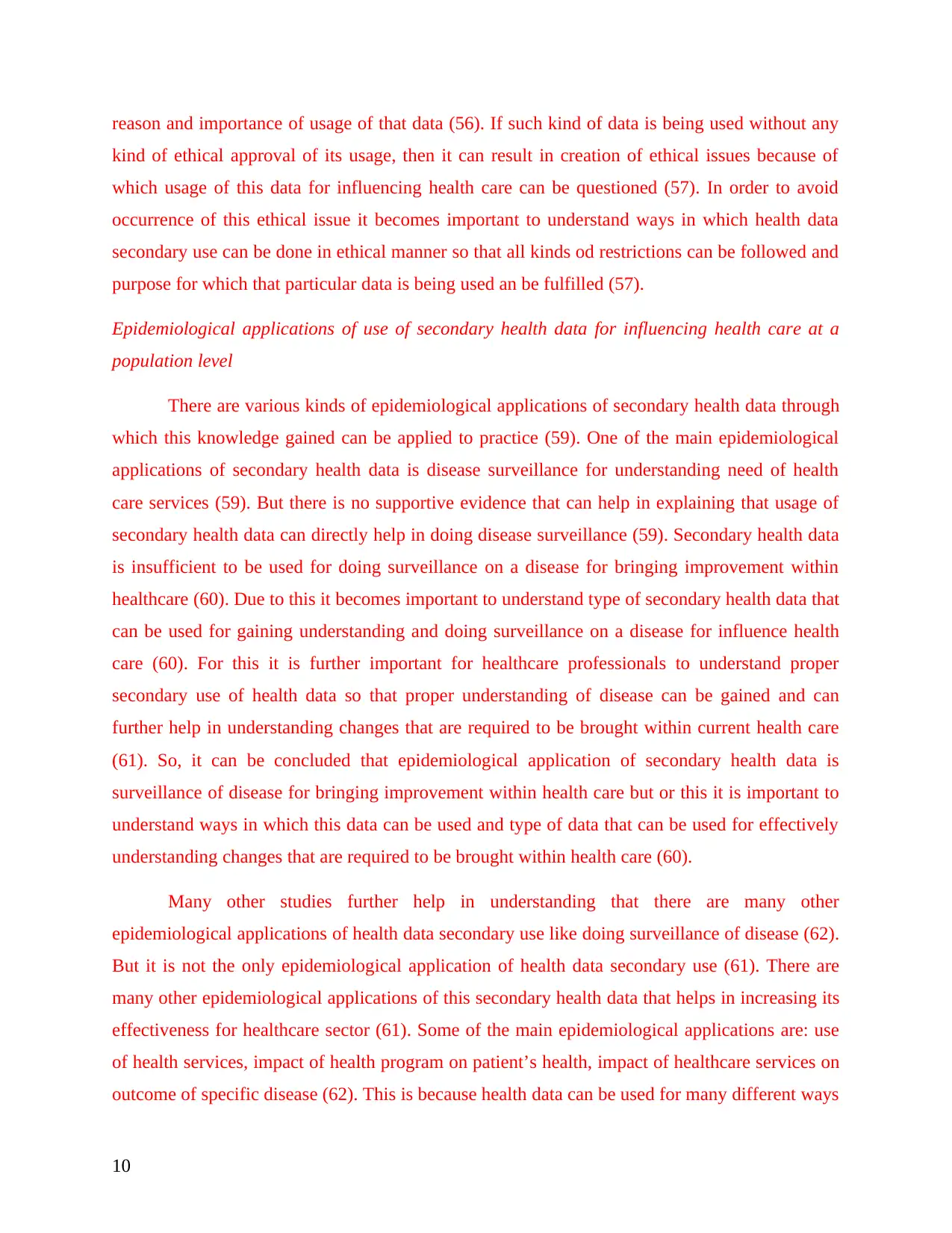
reason and importance of usage of that data (56). If such kind of data is being used without any
kind of ethical approval of its usage, then it can result in creation of ethical issues because of
which usage of this data for influencing health care can be questioned (57). In order to avoid
occurrence of this ethical issue it becomes important to understand ways in which health data
secondary use can be done in ethical manner so that all kinds od restrictions can be followed and
purpose for which that particular data is being used an be fulfilled (57).
Epidemiological applications of use of secondary health data for influencing health care at a
population level
There are various kinds of epidemiological applications of secondary health data through
which this knowledge gained can be applied to practice (59). One of the main epidemiological
applications of secondary health data is disease surveillance for understanding need of health
care services (59). But there is no supportive evidence that can help in explaining that usage of
secondary health data can directly help in doing disease surveillance (59). Secondary health data
is insufficient to be used for doing surveillance on a disease for bringing improvement within
healthcare (60). Due to this it becomes important to understand type of secondary health data that
can be used for gaining understanding and doing surveillance on a disease for influence health
care (60). For this it is further important for healthcare professionals to understand proper
secondary use of health data so that proper understanding of disease can be gained and can
further help in understanding changes that are required to be brought within current health care
(61). So, it can be concluded that epidemiological application of secondary health data is
surveillance of disease for bringing improvement within health care but or this it is important to
understand ways in which this data can be used and type of data that can be used for effectively
understanding changes that are required to be brought within health care (60).
Many other studies further help in understanding that there are many other
epidemiological applications of health data secondary use like doing surveillance of disease (62).
But it is not the only epidemiological application of health data secondary use (61). There are
many other epidemiological applications of this secondary health data that helps in increasing its
effectiveness for healthcare sector (61). Some of the main epidemiological applications are: use
of health services, impact of health program on patient’s health, impact of healthcare services on
outcome of specific disease (62). This is because health data can be used for many different ways
10
kind of ethical approval of its usage, then it can result in creation of ethical issues because of
which usage of this data for influencing health care can be questioned (57). In order to avoid
occurrence of this ethical issue it becomes important to understand ways in which health data
secondary use can be done in ethical manner so that all kinds od restrictions can be followed and
purpose for which that particular data is being used an be fulfilled (57).
Epidemiological applications of use of secondary health data for influencing health care at a
population level
There are various kinds of epidemiological applications of secondary health data through
which this knowledge gained can be applied to practice (59). One of the main epidemiological
applications of secondary health data is disease surveillance for understanding need of health
care services (59). But there is no supportive evidence that can help in explaining that usage of
secondary health data can directly help in doing disease surveillance (59). Secondary health data
is insufficient to be used for doing surveillance on a disease for bringing improvement within
healthcare (60). Due to this it becomes important to understand type of secondary health data that
can be used for gaining understanding and doing surveillance on a disease for influence health
care (60). For this it is further important for healthcare professionals to understand proper
secondary use of health data so that proper understanding of disease can be gained and can
further help in understanding changes that are required to be brought within current health care
(61). So, it can be concluded that epidemiological application of secondary health data is
surveillance of disease for bringing improvement within health care but or this it is important to
understand ways in which this data can be used and type of data that can be used for effectively
understanding changes that are required to be brought within health care (60).
Many other studies further help in understanding that there are many other
epidemiological applications of health data secondary use like doing surveillance of disease (62).
But it is not the only epidemiological application of health data secondary use (61). There are
many other epidemiological applications of this secondary health data that helps in increasing its
effectiveness for healthcare sector (61). Some of the main epidemiological applications are: use
of health services, impact of health program on patient’s health, impact of healthcare services on
outcome of specific disease (62). This is because health data can be used for many different ways
10
Paraphrase This Document
Need a fresh take? Get an instant paraphrase of this document with our AI Paraphraser
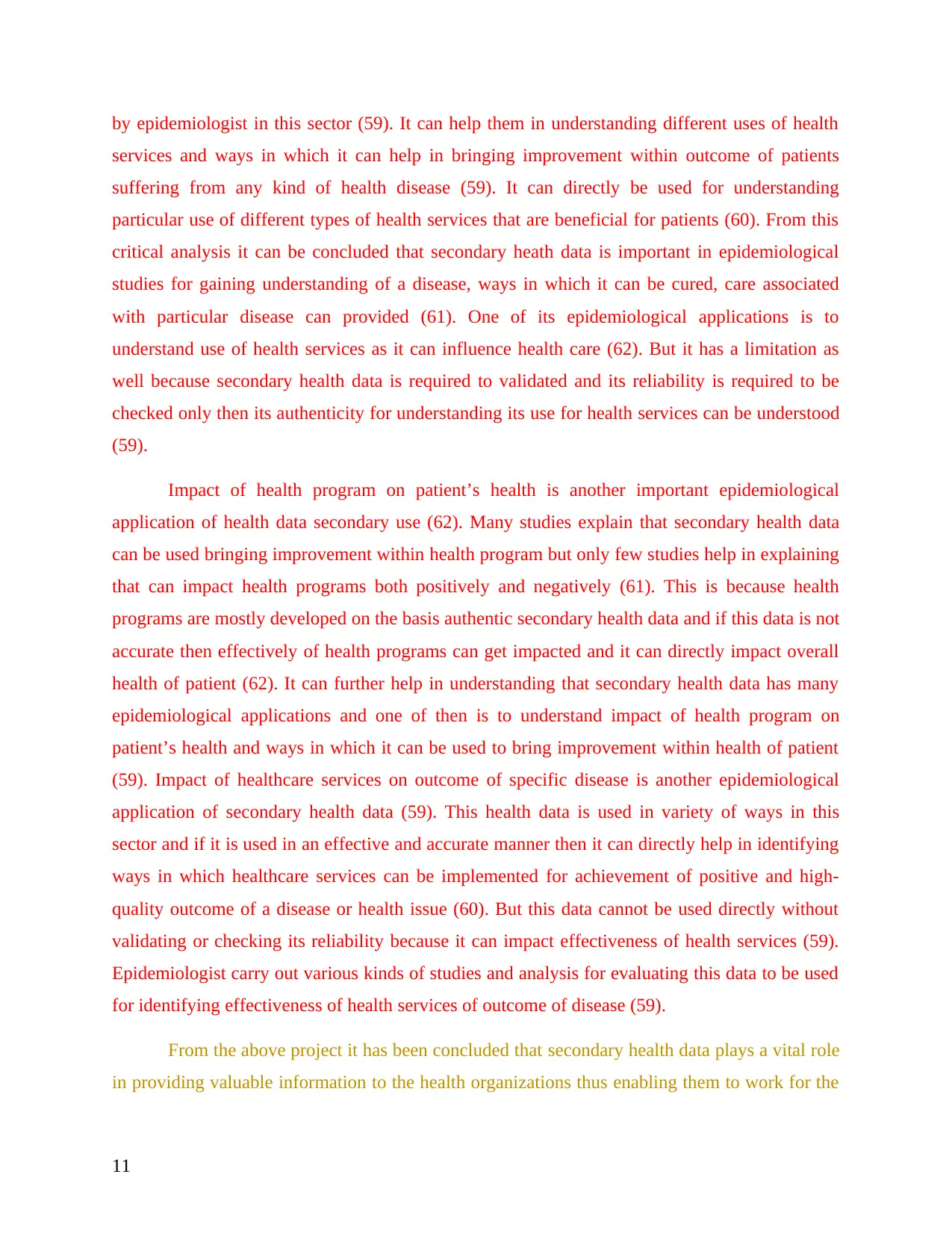
by epidemiologist in this sector (59). It can help them in understanding different uses of health
services and ways in which it can help in bringing improvement within outcome of patients
suffering from any kind of health disease (59). It can directly be used for understanding
particular use of different types of health services that are beneficial for patients (60). From this
critical analysis it can be concluded that secondary heath data is important in epidemiological
studies for gaining understanding of a disease, ways in which it can be cured, care associated
with particular disease can provided (61). One of its epidemiological applications is to
understand use of health services as it can influence health care (62). But it has a limitation as
well because secondary health data is required to validated and its reliability is required to be
checked only then its authenticity for understanding its use for health services can be understood
(59).
Impact of health program on patient’s health is another important epidemiological
application of health data secondary use (62). Many studies explain that secondary health data
can be used bringing improvement within health program but only few studies help in explaining
that can impact health programs both positively and negatively (61). This is because health
programs are mostly developed on the basis authentic secondary health data and if this data is not
accurate then effectively of health programs can get impacted and it can directly impact overall
health of patient (62). It can further help in understanding that secondary health data has many
epidemiological applications and one of then is to understand impact of health program on
patient’s health and ways in which it can be used to bring improvement within health of patient
(59). Impact of healthcare services on outcome of specific disease is another epidemiological
application of secondary health data (59). This health data is used in variety of ways in this
sector and if it is used in an effective and accurate manner then it can directly help in identifying
ways in which healthcare services can be implemented for achievement of positive and high-
quality outcome of a disease or health issue (60). But this data cannot be used directly without
validating or checking its reliability because it can impact effectiveness of health services (59).
Epidemiologist carry out various kinds of studies and analysis for evaluating this data to be used
for identifying effectiveness of health services of outcome of disease (59).
From the above project it has been concluded that secondary health data plays a vital role
in providing valuable information to the health organizations thus enabling them to work for the
11
services and ways in which it can help in bringing improvement within outcome of patients
suffering from any kind of health disease (59). It can directly be used for understanding
particular use of different types of health services that are beneficial for patients (60). From this
critical analysis it can be concluded that secondary heath data is important in epidemiological
studies for gaining understanding of a disease, ways in which it can be cured, care associated
with particular disease can provided (61). One of its epidemiological applications is to
understand use of health services as it can influence health care (62). But it has a limitation as
well because secondary health data is required to validated and its reliability is required to be
checked only then its authenticity for understanding its use for health services can be understood
(59).
Impact of health program on patient’s health is another important epidemiological
application of health data secondary use (62). Many studies explain that secondary health data
can be used bringing improvement within health program but only few studies help in explaining
that can impact health programs both positively and negatively (61). This is because health
programs are mostly developed on the basis authentic secondary health data and if this data is not
accurate then effectively of health programs can get impacted and it can directly impact overall
health of patient (62). It can further help in understanding that secondary health data has many
epidemiological applications and one of then is to understand impact of health program on
patient’s health and ways in which it can be used to bring improvement within health of patient
(59). Impact of healthcare services on outcome of specific disease is another epidemiological
application of secondary health data (59). This health data is used in variety of ways in this
sector and if it is used in an effective and accurate manner then it can directly help in identifying
ways in which healthcare services can be implemented for achievement of positive and high-
quality outcome of a disease or health issue (60). But this data cannot be used directly without
validating or checking its reliability because it can impact effectiveness of health services (59).
Epidemiologist carry out various kinds of studies and analysis for evaluating this data to be used
for identifying effectiveness of health services of outcome of disease (59).
From the above project it has been concluded that secondary health data plays a vital role
in providing valuable information to the health organizations thus enabling them to work for the
11
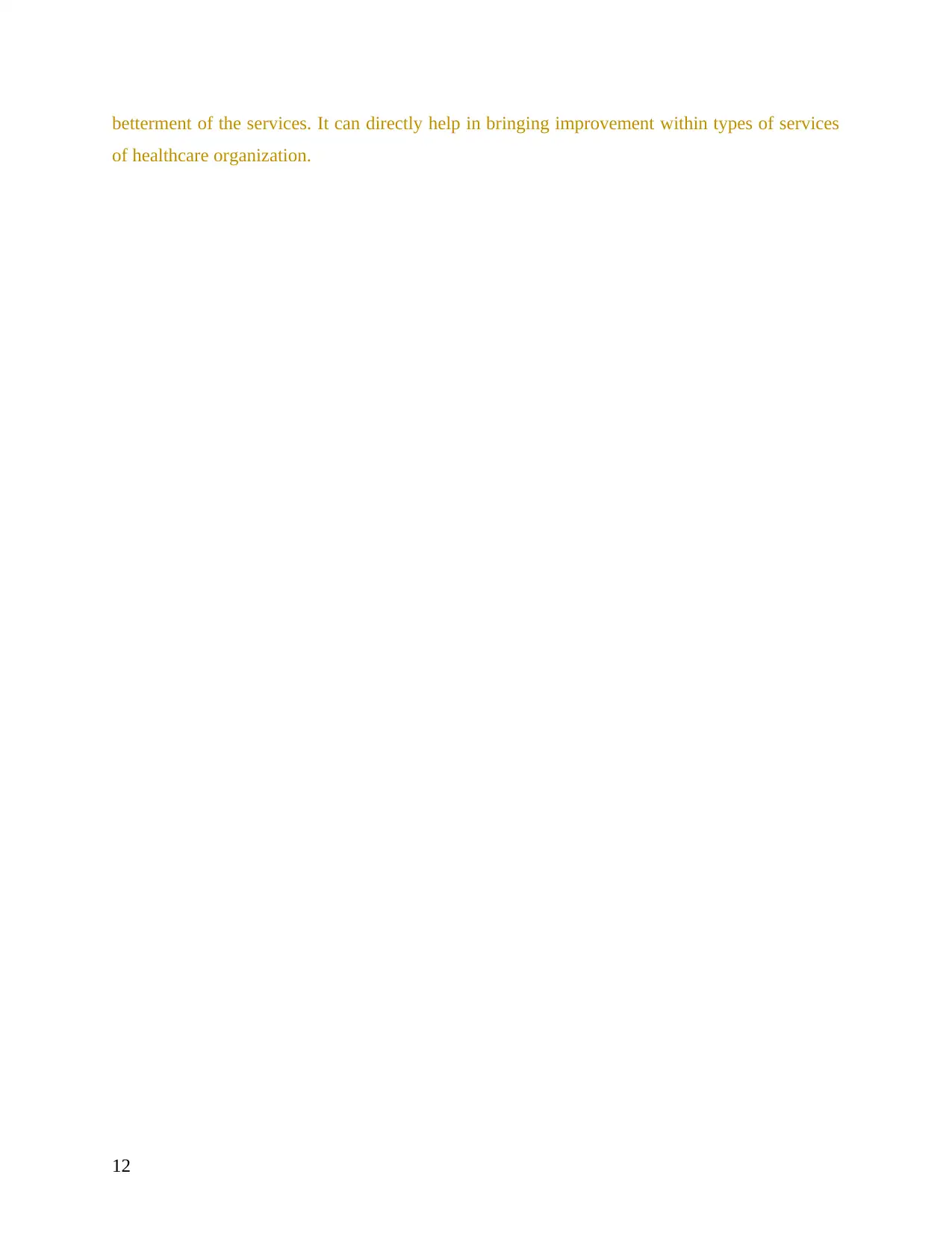
betterment of the services. It can directly help in bringing improvement within types of services
of healthcare organization.
12
of healthcare organization.
12
⊘ This is a preview!⊘
Do you want full access?
Subscribe today to unlock all pages.

Trusted by 1+ million students worldwide
1 out of 39
Related Documents
Your All-in-One AI-Powered Toolkit for Academic Success.
+13062052269
info@desklib.com
Available 24*7 on WhatsApp / Email
![[object Object]](/_next/static/media/star-bottom.7253800d.svg)
Unlock your academic potential
Copyright © 2020–2025 A2Z Services. All Rights Reserved. Developed and managed by ZUCOL.



